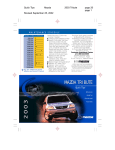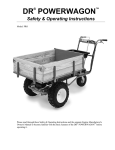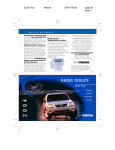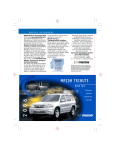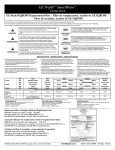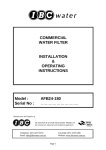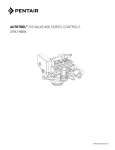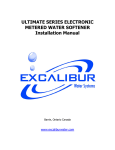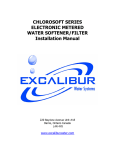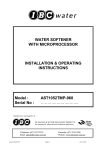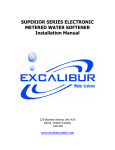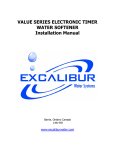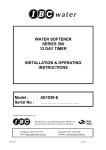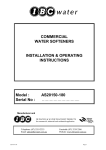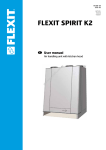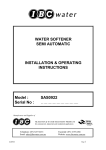Download AFM12-263 - IBC Water
Transcript
AUTOMATIC MULTI MEDIA FILTER INSTALLATION & OPERATING INSTRUCTIONS Model: AFM12-263 Serial No: ………………………… Manufacturer and Supplier of FILTRATION & WATER TREATMENT PRODUCTS for commercial, industrial and residential application Telephone: (07) 3219 2233 Email: [email protected] Facsimile: (07) 3219 2266 Website: www.ibcwater.com.au -1- TYPICAL CONTROL VALVE ASSEMBLE TOP STRAINER TO CONTROL VALVE BODY (Push in and twist) RISER PIPE ASSEMBLY (Located centrally in strainer) (When valve is screwed into tank) NOTE: ON A NUMBER OF SOFTENER MODELS & FILTERS IT IS NECESSARY TO PACKAGE THE VALVE WITH THE TOP STRAINER SUPPLIED LOOSE. IT IS IMPORTANT THAT THIS STRAINER AS ASSEMBLED TO THE VALVE DURING INSTALLATION. THE LENGTH OF THE INTERNAL RISER PIPE IS FACTORY ADJUSTED FOR THE TANK SIZE PROVIDED. DO NOT SHORTEN THIS PIPE UNDER ANY CIRCUMSTANCES -2- OPERATION The multi media filter is designed to remove particular matter. It will not remove colloidal matter, this matter is very fine particles usually not visible to the naked eye but in their finest form impart colour to the water. Colloids remain in suspension even when the water is virtually at rest. The multi media filtration system comprises a vessel or tank with various layers of filtration media. Each layer is designed to remove a specific size of particle and at the bottom is a very fine layer of media, which produces the high quality water from this style of filter. The top mounted control valve controls the cleaning of the media. This valve directs the flow of water through the tank, in the service cycle the flow is directed down through the media into the bottom strainer of the riser pipe and up through the centre of the riser pipe and through various valve ports to the service line. The cleaning cycle consists of two phases. Phase 1 being back washing of the media. In back washing the control valve directs the incoming water down through riser pipe to the bottom of the tank and lift the media bed and removes the entrapped dirt/matter back through the control valve to waste. Phase 2 The media then settles back and the media is then rinsed to waste in a down flow purge operation and the system returns to the service cycle. All the above is automatically controlled by the Model 263 Control Valve fitted with the 440i low voltage timer control. The 440i low voltage timer control is a 12 volt system. The valve comes complete with a mains 240/12V transformer. The lead of the transformer plugs into the single pin connector mounted on the back of the timer motor. It is necessary to remove the valve cover to accomplish this connection. The day dial on the 440i timer controls the frequency of cleaning the media. This is a seven-day dial with the days of the week highlighted. To clean the filter on a specific day push in the metal pin located on that specific day. For days' cleaning is not required the metal pins must be fully out. To set the time of day function it is necessary to grip the time of day black arm and pull upwards and rotate to match up the actual time of day. The timer gear function is designed to clean the filter in the early hours of the morning 2.00-2.30 am. If a different time is desired it is necessary to offset the actual time of day setting by the difference desired. Eg. if you wish it to clean at 8.00 am and the actual time of day was noon you would set the time of day at 6.00 am, The frequency of cleaning can only be determined under the specific site conditions. It is recommended that inlet and outlet pressure gauges are installed and the pressure differential is noted when the filter is first put into service, ie. the difference between the inlet and outlet pressure gauges when water is flowing through the filter. As the dirt is being removed by the filter, the pressure differential will increase. -3- The inlet pressure reading will rise and the outlet pressure will drop. When the pressure difference increases by 35Kpa (5psi) over than what it was when clean at the beginning. Then the filter needs to be back washed. Eg. if on first starting the filter the pressure differential was 60 kPa then when it increases to 105Kpa the filter should be cleaned. However, as the control is a time based system then it has to be related to days of operation. If in the example above it took 3 days to reach the increase for the 35Kpa pressure differential then the filter should be cleaned every third day. If pressure gauges are not available then it is suggested to initially set up the unit to clean every third day eg. Wednesday, Friday, Sunday and then adjust these settings if necessary based on loss of pressure and flow rate. However, the unit must be cleaned at least once a week. The filter can be manually initiated for cleaning by pressing black button in and turning slightly anti-clockwise and it will then electrically start a clean, after about a 10 minute delay. If power has been lost then the filter can still be cleaned manually by removing the top valve cover. Pressing in the black button and holding this in rotate the camshaft in an anti-clockwise rotation to the backwash position ie. the back three cam lobes riding on the brass valve ends. Leave in this position for 15-20 minutes. Once again push and hold in the black button and rotate until the fourth back cam lobe is pushing the brass valve end. Leave for 8-10 minutes and then push knob in and rotate camshaft so that black button is just near but not on the service position. This will enable clean water to service. When power is restored the button will rotate back to the service position. The reason for not bringing the button back manually to the service position is that if you go too far when power is restored it may initiate another backwash. It is important that the little black flag like locator situated at the bottom left hand side of the 440i timer be not pulled out whilst the unit is in operation. This locator is used to fix the timer in correct alignment with the camshaft and should only be removed for maintenance of the control valve or timer. PERFORMANCE DATA Table 1 Model Service Flow Rate 1.p.m. Backwash Flow Rate 1.p.m. Inlet Outlet Male Mm Approx. Shipping Weight kg AFM12 55 41 25 105 Water Temperature: 5O C - 45 O C Water pH: 5.5 – 9.0 Suspended Solids: Max. 100 mg/l Iron: No Effect Hydrocarbons: Nil -4- WARNING For proper operation, the inlet water pressure must be between 210 kPa and 690 kPa. If the inlet pressure exceeds 690 kPa, a pressure reduction valve must be fitted prior to the filter. If water hammer is prevalent, a water hammer arrestor must also be fitted after the filter. Ie. Between the filter and the device causing the effect. Failure to observe the above will VOID warranty. An Integral Backflow Prevention device must be fitted to the influent supply. The Installation must comply with all relevant local and State/Australian Standards Plumbing Codes. CAUTION: DO NOT USE WHERE WATER IS MICROBILOGICALLY UNSAFE OR WITH WATER OF UNKNOWN QUALITY INSTALLATION 1. Position the filter on a flat surface close to a drain or a properly trapped outlet and in a position where the filter can service all the lines, which require filtered water. The filter should be placed far enough away from a water heater to avoid any hot water backup into the filter. The AF model filters require a standard or weatherproof 3-pin 10-amp power point, depending on the location of filter installation. 2. Refer page 10 of “Series 263 Installation, Operation & Maintenance Manual” for plumbing instructions. 3. Remove filter valve from carton. Attach top strainer to bottom of valve. Plug or cover the top end of riser pipe in the tank making sure no media can enter the tube. 4. Fill tank to about 1/3 full with water, making sure the riser pipe is sitting in the middle of the tank. Then using a wide mouth funnel place the media in the tank as follows – levelling each layer before placing next media into the tank. DO NOT shake filter to level the media. 5. Remove the plug or cover from the riser pipe making sure you DO NOT lift the riser pipe. Top up tank with water. Screw valve onto the tank (hand tight is usually sufficient), making sure the distributor tube is properly inserted into the top strainer -5- MEDIA PLACEMENT MULTI MEDIA SEDIMENT FILTER Sequence in Tank AFM12 1st 8kg #6 Gravel 2nd 17kg D1 3rd 14kg D2 4th 26kg 7M Sand 5th 20kg D3 -6- 440i Low Voltage Timer Control Low Voltage Transformer Only use the included transformer for powering the 440i timer. Connect the plug of the transformer secondary cable to the mating socket at the rear of the timer housing on the motor Increasing the length of the Transformer cord If it is necessary to extend the length of the transformer cord, an optional 15 foot (4.6m) extension is available Extension Cord - Part No. 1000907 Be certain that the transformer is plugged into a correct voltage source -7- Series 263 3-Cycle Control System for Automatic Filters Installation, Operation and Maintenance Manual -8- TABLE OF CONTENTS Installation ………………………………………………. 10 Location Selection Water Line Connection Drain Line Connection Electrical Connection Placing Conditioner into Operation …………………. 11 Adjustment of timer …………………………………….. 12 Special Features of Timer Removing Control Module for Servicing …………… 12 Removing 440I for Servicing ………………………….. 13 Valve Disc Operation …………………………………… 13 Valve Disc Identification ……………………………… 13 Specifications …………………………………………… 14 Flow Diagrams …………………………………………. 15 Pressure Loss Characteristics ……………………… 15 Replacement Parts …………………………………….. 16, 17, 18 Trouble Shooting ……………………………………….. 19 -9- Installation All plumbing and electrical connections must conform to local codes. Inspect unit carefully for carrier shortage or shipping damage. Location Selection 1. The distance between the unit and a drain should be as short as possible. 2. It is likely that supplementary water treating equipment will be required, make certain adequate space is available Figure 1 3. Do not install unit closer to a water heater than a total run of 10 feet (3m) of piping between the outlet of the conditioner and the inlet to the heater. Water heaters can sometimes overheat to the extent they will transmit heat back down the cold pipe into the unit control valve. Hot water can severely damage the conditioner. A 10 foot (3m) total pipe, including bends, elbows, etc., is a reasonable to help prevent this possibility. A positive way to prevent hot water from flowing from heat source to the conditioner, in the event of a negative pressure situation, is to install a check valve in the water piping from the conditioner. If a check valve is installed, make certain the water heating unit is equipped with a properly rated temperature and pressure safety relief valve. Also, be certain that local codes are not violated 4. DO not locate unit where it or its connections (including the drain and overflow lines) will ever be subjected to room temperatures under 34ºF (1ºC) or over 120ºF (49ºC). 5. Do not install unit near acid or acid fumes. Water Line Connections A bypass valve system must be installed since there may be occasions when the water conditioner must be bypassed for unfiltered water or for servicing. The most common bypass systems are the Autotrol Bypass Valve (Figure 1) and plumbed-in globe valves (Figure 2). Though both are similar in function, the Autotrol Bypass offers simplicity and ease of operation. - 10 - Figure 2 Drain Line Connection 1. If ideally located, the unit will be above and not more than 20 feet (6.1m) from the drain. For such installations connect 1/2-inch (1.3cm) plastic tubing to drain line connection located on the control. 2. If he unit is located more than 20 feet (6.1m) from drain, use 3/4-inch (1.9cm) tubing for runs up to 40 feet (12.2m). Also purchase adapter to bush tubing down to drain line connection fitting. 3. If unit is located where the drain line must be elevated, you may elevate the line up to 6 feet (1.8m) providing the run does not exceed 15 feet (4.6m) and water pressure at conditioner is not less than 40 psi (2.8 BAR). You may elevate an additional 10 psi (0.7 BAR). 4. Where drain line is elevated but empties into a drain below the level of the control valve, from a 7-inch (18cm) loop at the far end of the line so that the bottom of the loop is level with the drain line connection. This will provide an adequate trap. Placing Conditioner into Operation After all previous steps have been completed, the unit is ready to be placed into operation. Follow these steps carefully. 1. Remove control valve cover by springing back the rear plastic tab at the end of the camshaft. Lift the back of the cover and slide forward. Caution Never connect drain line into a drain, sewer line or trap. Always allow an air gap between the drain line and the wastewater to prevent the possibility of sewage being backsiphoned into conditioner. Note: The following steps will require you turning the pointer knob, (Figure 4), to various positions. Insert a wide blade screwdriver into arrow slot in pointer knob and press firmly. With the knob held in, rotate COUNTERCLOCKWISE only until arrow or knob points to desired position. (Rotation is made much easier if you grasp the camshaft with your free hand and turn it at the same time). Then permit the knob to spring back out. 2. Insert screwdriver into slot in pointer knob, (Figure 4). Press in and rotate knob COUNTERCLOCKWISE until arrow points directly to the word BACKWASH. 3. Fill mineral tank with water. A. With water supply off, place the bypass valve(s) into the "not in bypass" position. B. Open water supply valve very slowly to approximately the 1/4 open position. C. When all of the air has been purged from the tank (water begins to flow steadily from the drain), open the main supply valve all the way. Figure 3 Electrical Connection - 240Volt 10amp Mains Supply. - Transformer supplied to reduce to 12V. - Plug lead end into socket on back of TIMER Motor. Caution If opened too rapidly or too far, media may be lost. In this position, you should hear air escaping slowly from the drain line. Figure 4 - 11 - D. Allow water to run to drain until clear. E. Turn off water supply and let the unit stand for about 5 minutes. This will allow all trapped air to escape from the tank. 4. Put into operation. A. Open water supply valve slowly to full open position. B. Advance pointer knob COUNTERCLOCKWISE to SERVICE. C. Run water from nearby faucet until the water is clear. Adjustment of Timer 1. Set days of regeneration on skipper wheel (Figure 4). • Pull all skipper pins outward (away from control). • Rotate skipper wheel until day arrow points to current day (7-day timer) or number 1 (6day timer). • Depress skipper pin(s) at day(s) for which regeneration is desired. Manual Regeneration. Electricity is used only to run the timer and rotate the camshaft. All other functions are operated by water pressure. Therefore, in the event of a power outage, all the various regeneration positions may be dialled manually by depressing the pointer knob and turning COUNTERCLOCKWISE. Manual time cycle: BACKWASH ………….. 20 minutes RINES …………………. 10 minutes Removing the valve assembly for servicing 1. Unplug the power cord. 2. Shut off water supply or put bypass valve into bypass position. 3. Remove cover and with screwdriver, relieve tank pressure by pushing open valve No. 7 (rear flapper on control as shown (Figure 8). 2. Set the time of day • Grasp timer knob and pull outward. • Rotate in either direction until actual time of -day on time dial is in line with time-ofday arrow. • Release timer knob. Note: With the time of day properly set, the conditioner will regenerate at about 2:30a.m. If you prefer to have the unit regenerate at an earlier or later time, simply set the time-of-day accordingly. Example: To have the unit REGENERATE/BACKWASH at 4:30 a.m. - 2 hours later - set the clock 2 hours earlier than the actual current time Special features of timer Guest Cycle. When abnormally high water usage exhausts your water conditioner's capacity ahead of schedule, an extra regeneration can be achieved by depressing the pointer knob with finger or wide blade screwdriver and turning COUNTERCLOCKWISE to START. It will take few minutes for regeneration to start. Normal regeneration schedule will not be disrupted. - 12 - Figure 8 4. When used with a globe valve bypass, loosen and detach the inlet, outlet, brine and drain lines from the valve. If using the 1264 bypass, loosen and remove valve from bypass as well as loosening and removing the brine and drain lines. 5. Unscrew (counterclockwise) and remove valve from tank. 6. To replace the control valve, reverse the above procedure. Removing 440i or 460i for servicing Valve Disc Principle of Operation 1. Unplug the power cord. 2. Remove the cover. 3. Align the indicator arrow on the rear of the camshaft with the top of the rear hoop of the top plate (Figure 16). Identification of Control Valving Figure 16 4. Remove the camshaft by carefully pushing the securing tab, located at the rear of the camshaft, away from the camshaft until the tab disengages from the camshaft. Push the back of the camshaft down and out to the inlet side of the valve (Figure 17). Figure 17 5. Disengage the front of the camshaft from the output gear of the control. 6. Remove the timer locking pin and lift the control straight up and off the valve. 7. To reinstall the camshaft and control, reverse the above procedures. - 13 - Specifications Hydrostatic Test Pressure ……………………………………………………………………. 300 psi (20.69 bar) Working Pressure …………………………………………………………………… 20-125 psi (1.38 - 8.62 bar) Standard Electrical Rating ……………………………………………………………………………. 115V 60 Hz Optional Electrical Rating …………………… 115V 50 Hz, 230V 50Hz, 200V 60 Hz, 24V 60Hz, 24V 50 Hz, 100V 60 Hz, 12V 50Hz/transformer, 12V 60 Hz/transformer Electrical Cord (standard rating) ………………………………………………. 60 inch (1.5m) 3-wire with plug Pressure Tank Thread ………………………………………………………………………….. 2 1/2 inch-8 male Riser Pipe Diameter Required ……………………………………………………….. 1.050 inch OD (26.7 mm) Riser Pipe Length …………………………1/1/8 ± 1/8 inches (31.8 mm) higher than the top of mineral tank Standard Connection …………………………………………………. 1-inch (25.4 mm) copper tube adapters Optional Connections …………………………………… 31/-inch, 22 mm, and 28 mm copper tube adapters 3/4-inch BSPT, 1-inch BSPT, 1-inch NPT brass pipe adapters 3/4-inch, 1-inch, 25 mm CPVC tube adapters Drain Line Connection ………………………………………………………………………… 3/4-inch NPT male Optional Bypass Valve …………………………………. Rotating handle, full 1-inch porting, reinforced Noryl Control Module, Tank Adapter …………………………………………………………………. Reinforced Noryl Rubber Goods ………………………………………………………………… Compound for cold water service Program Clock (Timer) …………………………………………………… 440i: Available in 6 or 7 day English - 14 - Flow Diagrams 1. Service Position 2. Backwash Position 3. Purge Position Pressure Loss Characteristics - 15 - Replacement Parts 1265 Bypass - 16 - Parts List code Part No Description 1 2 3 4 5 6 1035606 1035624 1301391 1000219 1010428 1032978 Valve Assembly Camshaft 440I Timer Locking Pin Drain Cap Riser O'ring Seal Injector Assembly: - Injector Injector Cap Assembly: - Cap Top Strainer Refill Control Plug Screen/Cap Assembly O'ring Tank Ring Plumbing Adapter Kits: 1-inch BSPT Plastic Pipe Adapter Kit External Backwash Flow Control AFM09 AFM12 Spring, Flapper Valve Valve Disc Kit: Standard Severe Service I-lid Cover 7 1000219 8 9 10 11 12 13 D1230 1030334 1000226 1010429 1035622 1001605 14 15 * MA02320FCFF MA04120FCFF 1001580 1041174 1041175 * 1000062 * Not Shown - 17 - Qty 1 1 1 1 1 1 1 1 1 1 1 1 1 1 1 1 1 440i Timer code Part No Description 1031740 1301742 1030659 1006091 1006601 1031756 1030830 1030821 Skipper Wheel Assembly: 6-Day 7-Day Washer Screw, No 6 x 1/2 in Bowed Washer Tripper Arm Assembly Spring Retainer 1 2 3 4 5 6 7 8 * 9 * 1001568 1000812 1000907 Motor, 12 Volt, 50 Hz Transformer: Australian Transformer Extension Cord 15 ft. (4.6m) - 18 - Qty 1 1 7 1 1 1 1 1 1 1 Caution Troubleshooting The technology upon which the series 263 control is based, is well established and proven in service over many years. However, should a problem or question arise regarding the operation of the system, the control can be very easily serviced. For parts mentioned refer to exploded views in the Replacement Parts section of this manual. Problem Service procedures that require the water pressure to be removed from the system are marked with a after the possible cause. To remove water pressure from the system, put the bypass valve or three-valve bypass into the bypass position and open the Backwash Drain Valve (the sixth valve back from the control) with a screwdriver. Restore system water pressure when the service work is completed. Possible Cause Solution 1. Control will not regenerate automatically. a. Electric cord unplugged. b. Skipper pins not down on time skipper wheel. c. Defective timer motor. a. Connect power. b. Depress pins for days regeneration required. c. Replace motor. 2. Control regenerates at wrong time. a. Timer set incorrectly. a. Make correct setting according to instructions. 3. Control backwashes at excessively low or high rate. a. Incorrect backwash controller used. b. Foreign matter affecting controller operation. a. Replace with correct size controller. b. Remove and clean controller. 4. Flowing or dripping water at drain after regeneration. a. Drain valve (5 or 6) held open by foreign matter or particle. b. Valve stem return spring on top plate weak. a. Manually operate valve stem to flush away obstruction. b. Replace spring. - 19 -





















